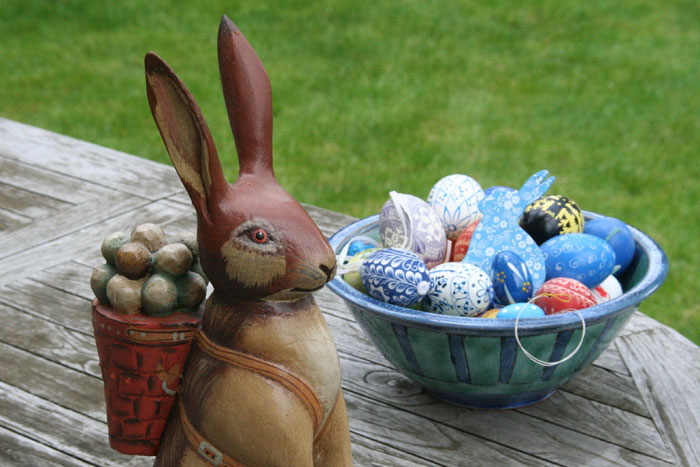复活节(Easter)是西方的一个重要节日,用来纪念耶稣基督复活(the resurrection of Jesus)。
在西方教会传统里,春分之后第一次满月之后的第一个星期日即为复活节。东方教会则规定,如果满月恰逢星期日,则复活节再推迟一周。因此,节期大致在3月22日至4月25日之间。
在这一天,人们不仅要滚彩蛋,还要吃巧克力兔。复活节为什么要吃巧克力兔呢?这要从复活兔说起了。

Photo by Bee Felten-Leidel on Unsplash
As far as holidays go, Easter is second only to Halloween in American candy sales—that’s a lot of chocolate bunnies.
就节假日而言,复活节的糖果销量在美国仅次于万圣节:其中有很多是巧克力兔。
Easter—the most spiritually significant holiday of the Christian calendar—has always been heavily associated with symbolic foods, from lambs to egg-rich celebratory breads. Rabbits, however, are not mentioned in the scriptures that recount Jesus’ crucifixion and resurrection. And chocolate, a New World food, was not even accessible to the masses until the mid-1800s. So how did chocolate bunnies come to dominate the Easter basket scene? It’s a thoroughly modern mash-up of commerce, confectionery, and immigration.
复活节在基督教历法中是最具有精神象征意义的节日,它一直与象征性的食物紧密联系,从羊羔肉到放很多鸡蛋的复活节面包。然而,在圣经中描述耶稣受难到复活的文字里并没有提到兔子。巧克力作为一种新世界的食物,直到19世纪中叶才广泛供应给民众。那么巧克力兔是如何占据复活节食篮的呢?这是现代商业、糖果和移民混合作用的结果。
The observance of Easter includes some elements adapted from pagan traditions celebrating cycles of new life in the springtime, and one of those is the rabbit, an animal known for its crazy-high fertility.
复活节的庆祝活动汲取了异教徒庆祝春天开始新生命轮回的一些传统元素,其中之一就是兔子,一种以高繁殖能力著称的动物。
pagan: adj. 异教的;异教徒的
Ostara, the Germanic pre-Christian fertility goddess, apparently kept a hare as a sidekick. The word for “Easter” (Ostern, in German) is derived from her name, and her namesake festival was held around April. Germans came to embrace the fictional character Oschter Haws (or osterhause), a rabbit who delivered eggs to children at Easter.
奥斯塔拉(Ostara)作为前基督教时代日耳曼民族的生育女神,养了一只野兔作为伙伴。复活节这个名词就是来源于她的名字(在德语里是Ostern),她的同名节日大概在四月份举行。后来德国人开始接纳虚构的角色“复活兔”,这是一只在复活节给孩子们送鸡蛋的兔子。
sidekick: n. 伙伴,老朋友
The Easter Bunny Museum in the now-defunct Center for Unusual Museums in Munich showcased examples of 19th century Easter rabbits made of cardboard, wood, or fabric, and some had removable heads to allow for hiding candy inside (these would be the forerunners to chocolate bunnies).
位于慕尼黑的复活节兔子博物馆(该博物馆所属的特殊博物馆中心现已关闭)展示了一些19世纪复活节兔子的样例,这些兔子由纸板、木头或布制成,有些兔子的头部是可以拆卸的,可以把糖果藏在里面。这些兔子可能是巧克力兔的前身。
At the same time, the middle classes of the Western world began enjoying the chocolaty fruits of progress. The Industrial Revolution changed chocolate from a costly drink to a cheap solid food. The craft of making the smooth-textured solid chocolate we’re familiar with today requires many steps, and those were not possible without mechanization; the first eating (as opposed to drinking) chocolates appeared in Europe in the mid-1800s.
与此同时,西方中产阶级开始享受巧克力这一社会进步的果实。工业革命将巧克力从一种昂贵的饮品变为廉价的固体食品。制作我们今天所熟悉的质地丝滑的固体巧克力需要很多步骤,没有机械化是不可能实现的。第一批能吃(而不是喝)的巧克力19世纪中期出现在欧洲。
The chocolate bunny had yet to cross the Atlantic, though. The Pennsylvania Dutch imported the Oschter Haws, or Easter Hare, who delivered colored eggs to good children. One of the better-known early sightings of chocolate rabbits in America was in 1890, when Pennsylvania shopkeeper Robert L. Strohecker featured a five-foot chocolate rabbit in his drugstore to attract business at Easter. And after that long journey, chocolate rabbits of more manageable proportions eventually became an Easter staple.
不过当时巧克力兔还没有横渡大西洋。宾夕法尼亚州的殖民者引进了复活兔的概念,也就是会给好孩子送彩蛋的兔子。复活节兔早期在美国最著名的一件事是1890年宾夕法尼亚州的商人罗伯特·L·施特罗埃克尔在他的杂货店里摆了一只5英尺(约合1.52米)高的巧克力兔子在复活节招揽生意。经过长期的发展,巧克力兔的尺寸变得更加合适,最终成为了复活节的一种主要食品。
来源:Mental Floss、煎蛋网
编译:丹妮
来源:煎蛋网
